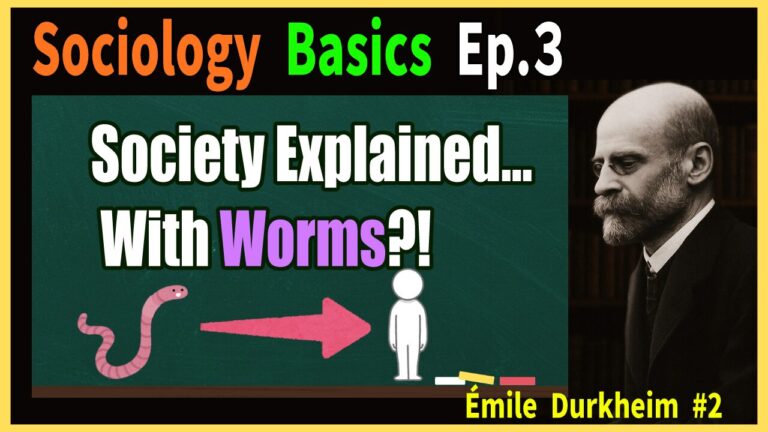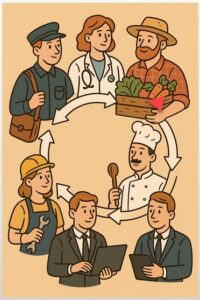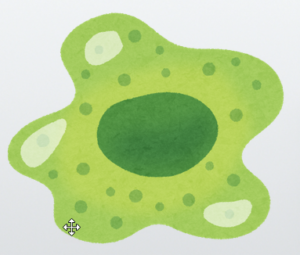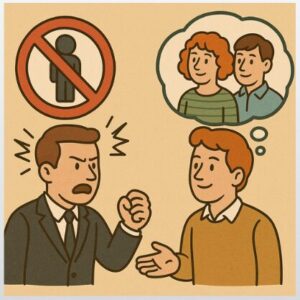Summary in the Video
Explanation in the video
The ‘Overview, Summary, or Conclusion’ of this article can be found at the beginning of the YouTube video, so please refer to it.
If possible, we would appreciate it if you could subscribe to our channel to help maintain the site. It serves as motivation for us!
(2-1) Introduction
This video series is structured around four major works by Émile Durkheim.
- The Division of Labor in Society (1893)
- The Rules of Sociological Method (1895)
- Suicide: A Study in Sociology (1897)
- The Elementary Forms of Religious Life (1912)
First, here is the overall structure of Durkheim’s The Division of Labor in Society.
This video focuses specifically on the concept of segmentary society and organized society within that framework.
The remaining topics will be discussed in the next video.
If you find this video helpful, please consider subscribing to the channel. It will motivate me to create the next one.
- Chronology
- What are the bonds that connect people to one another?
- What is division of labor and what are its functions?
- Why does division of labor produce social solidarity?
- [Column] What is sociology?
- The difference between mechanical solidarity and organic solidarity
- The difference between segmentary society and organized society
- Collective conscience and collective representations
- [Column] What is sociological theory?
- Examination of solidarity: repressive law and restitutive law
- Non-contractual elements in contracts
- A society without crime is unhealthy
- [Column] Durkheim’s critique of Tönnies
- Is individualism detrimental to solidarity?
- Coercive division of labor and anomic division of labor
- Intermediate groups as a measure against the adverse effects of modernization
(2-2) What is a Segmentary Society?
POINTsegmentary society:A term that means a society composed of multiple similar and autonomous groups arranged in parallel, which are integrated through shared values.
It is also referred to as a “segmented society.” In Durkheim’s terminology, it corresponds to a society in which mechanical solidarity is dominant.
・What is segmentary ?
The term segmentary comes from biology, where a segment refers to a joint or connection between parts.
Segmented animals include creatures such as earthworms and centipedes.
The word segment is derived from the idea of a circular or ring-like shape.
Segmentary society is likely named after the body of an earthworm, which is composed almost entirely of similar, repeated parts.
It conveys an image of groups that are structurally and functionally similar, yet connected to form a whole.
Durkheim referred to the simplest type of social structure as a horde, which he considered the protoplasm of society.
(2-3) What is an Organized Society?
POINTorganized society:A term that means a society in which people with different roles, created through the division of labor, functionally depend on one another and are integrated accordingly.
Durkheim himself did not use the term “organized society”; this label was adopted by later sociologists. In Durkheim’s terms, it refers to a society characterized by organic solidarity, also known as a differentiated society.
In an extreme sense, a segmentary society is one where everyone hunts together, prepares meals together, and participates in politics together without having specific, fixed roles.
In an organized society, people are divided into distinct roles, and these roles become further specialized within politics, the economy, and the family, forming a complex social organization.
What is Organization?
Generally, organization means ordering and systematizing individual elements or actions so that they function effectively toward a specific goal.
For example, the human body is organized, where individual parts such as the heart, brain, intestines, and pancreas function effectively—whether actively or as a result—to maintain life and homeostasis.
The term “organized society” refers to a society in which elements are more complex, differentiated, systematic, and interdependent.
It is not a society like a simple organism such as an amoeba, which can survive independently even if separated.
Since the modern era, collective consciousness has tended to prioritize rationality, discipline, and profitability for organizational cohesion rather than emotional bonds based on friendship or kinship.
In Max Weber’s terms, this resembles the concept of bureaucracy.
Of course, this does not mean that pre-modern societies were completely unorganized; for example, military forces have been strongly organized throughout all historical periods.
However, in the military, it is undesirable for the organization to collapse if a member is missing.The structure needs to be impersonal so that anyone can be replaced without disrupting the whole unit.
In this sense, modern military organizations are, in some respects, similar to segmental societies.
Indeed, in Durkheim’s Suicide (1897), he notes that modern armies show a high incidence of altruistic suicide, a pattern typical of pre-modern collective societies.
Thus, the military can be seen as an exceptional social formation.
(2-4) Why Has the Dichotomy Between Mechanical Solidarity and Organic Solidarity Been Largely Abandoned?
What were the problems with the theory of social change that claimed societies move from mechanical solidarity to organic solidarity, or from segmental societies to organized societies?
Why has the dichotomy between mechanical and organic solidarity largely fallen out of use?
Social life
Durkheim uses the term “social life” in The Division of Labor in Society.
POINTSocial life:A concept that means a social entity whose cohesion fundamentally depends on shared beliefs and collective practices.
Importantly, Durkheim argues that division of labor presupposes social life.
Social life has strong aspects of mechanical solidarity and segmental society.
Social life thus embodies strong cohesion based on shared beliefs and homogeneity.
Therefore, the statement “organic solidarity requires mechanical solidarity” holds true, making it difficult to explain social cohesion with a simple dichotomy.
The traditional schematic is too simplistic.
Rather than mechanical solidarity being replaced by organic solidarity, both coexist to some extent and mutually support each other.
A certain degree of commonality forms the foundation on which individuality and division of labor can flourish.
Organic solidarity requires mechanical solidarity, and vice versa, which makes them complementary in nature.
At the same time, there are also mutually exclusive aspects between the two.
For example, mechanical solidarity tends to eliminate individuality as much as possible.
In contrast, organic solidarity tends to accept and even encourage individuality.
In this sense, the two forms of solidarity are in some ways incompatible.
In such conflicts, social harmony may be achieved through context-dependent judgments that distinguish between desirable and undesirable forms of individuality.
However, making such judgments is inherently difficult.
This is precisely why issues like LGBTQ rights continue to generate intense public debate.
Then, which specific elements of mechanical solidarity are essential even within an organically integrated society?
Simply put, it is the sense of emotional attachment to one’s social group.
More concretely, this includes attachment to a shared land, reverence for ancestors, and the commonality of customs.
Without such attachment, competition for survival among members would accelerate, people would become fragmented, and division of labor would fail to generate solidarity.
The division of labor and competition have social significance, which lies in the fact that they are forms of contribution.
However, this requires a shared consciousness that our society is one in which such contributions have value.
In Durkheim’s terms, the development of division of labor depends on the increase in dynamic density, but this also presupposes a certain level of moral density―that is, a sense of attachment to one’s social group.
Weber’s observation of the Protestant belief in being forgiven by God may also be interpreted as a form of moral density.
It is not merely competition among isolated individuals, but rather the awareness that such competition is connected to something holistic and transcendent beyond the individual.
That transcendent whole is, of course, what we call society.
Durkheim emphasized patriotism, as he believed that a truly global society had not yet been formed at the level of all humanity.
For example, a desire like “I want to do something for my country” transforms what would otherwise be mere division of labor into a form of labor that generates solidarity.
Organic solidarity could not have emerged without the prior existence of mechanical solidarity.
A new form of order (solidarity) cannot arise from chaos alone.
Moreover, once organic solidarity has developed, it does not mean that mechanical solidarity entirely disappears.
This point highlights the importance of recognizing gradation, rather than treating these forms of solidarity as a binary of 1 or 0.
It is more appropriate to discuss their relative predominance or mutual balance within a given context, rather than assuming that one is absolutely inferior and should be reduced to zero.
Durkheim’s sociological sensibility is characterized by a persistent emphasis on the notion of moderation.
This resonates with the philosophy of Aristotle, who argued that virtue lies in the pursuit of the mean between extremes.
Just like a bath that is too cold or too hot can be harmful to the body, the ideal temperature arises through the balance of both extremes.
This sense of moderation also echoes Weber’s idea of balancing passion and rationality in one’s consciousness.
Weber once remarked that “Politics is a strong and slow boring of hard boards. It takes both passion and perspective.”
References
Recommended Readings
Emile Durkheim「The Division of Labor in Society」
Emile Durkheim「「The Division of Labor in Society」
DK Publishing, Sarah Tomley「The Sociology Book: Big Ideas Simply Explained (DK Big Ideas) (English Edition)」
About the Japanese version of this article
This article is a translation of an article written in [https://souzouhou.com/2024/11/27/durkheim-4-1/]. For detailed references, please refer to this link.








Comments